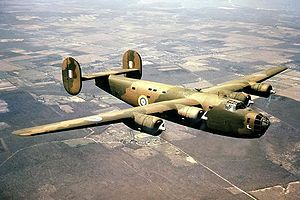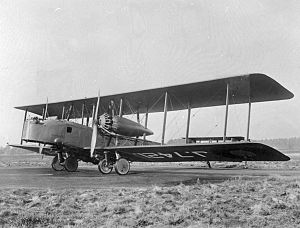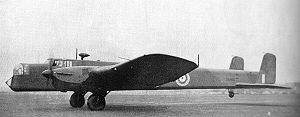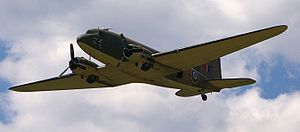- No. 4 Group RAF
-
No. 4 Group RAF Active 1 April 1918 - 24 March 1919
1 April 1937 - 2 February 1948Country  United Kingdom
United KingdomBranch  Royal Air Force
Royal Air ForcePart of RAF Bomber Command
(April 1937 - May 1945)
RAF Transport Command
(May 1945 - February 1948)Group Headquarters RAF Linton-on-Ouse
(April 1937 - January 1940)
Heslington Hall
(January 1940 - February 1948)Commanders Notable
commandersMarshal of the Royal Air Force Arthur "Bomber" Harris No. 4 Group was a Royal Air Force group, originally formed in World War I, and reformed in the wake of the Second World War, mostly part of RAF Bomber Command, but ending its days in RAF Transport Command.
Contents
History
Formation in World War I
No. 4 Group was originally formed in October 1918 at Felixstowe just before the end of World War I and disbanded a year later in 1919. In its first incarnation, No. 4 Group was created by augmenting the former Royal Naval Air Service group at RNAS Great Yarmouth which had been responsible for anti-submarine and anti-Zeppelin operations over the North Sea. The former RNAS group was designated as No. 73 Wing within the new No. 4 Group. The commanding officer of No. 4 Group was Colonel C R Samson.[1] With the 1918-1919 post-War demobilization of the RAF, No. 4 Group was disbanded on 24 March 1919.
Reformation in World War II
With the build up of the RAF prior to the outbreak of World War II, No. 4 Group was reformed on 1 April 1937 as part of RAF Bomber Command based at RAF Mildenhall, Suffolk under A/Cdre Arthur Harris (later Air Vice-Marshal "Bomber" Harris). On 29 June 1937 the headquarters were re-located at Linton-on-Ouse, Yorkshire when 4 Group took over a number of stations and squadrons from No. 3 Group RAF. The flying units of those were these, mainly flying with the Handley Page Heyford biplane bomber:
Order of battle for no. 4 Group RAF, 29 June 1937, data from[2][3] Base Squadron Aircraft Version RAF Dishforth No. 10 Squadron RAF
No. 78 Squadron RAFHandley Page Heyford
Armstrong Whitworth Whitley
Handley Page HeyfordMks.IA, III
Mk.I
Mks.II, IIIRAF Driffield No. 77 Squadron RAF
No. 102 Squadron RAFHawker Audax
Handley Page Heyford
Mks.II, IIIRAF Finningley No. 7 Squadron RAF
No. 76 Squadron RAFHandley Page Heyford
Vickers Wellesley
Vickers WellesleyMks.II, III
Mk.I
Mk.IRAF Leconfield No. 166 Squadron RAF Handley Page Heyford Mk.III RAF Linton-on-Ouse
(Previously at RAF Boscombe Down)No. 51 Squadron RAF
No. 58 Squadron RAFVickers Virginia
Avro Anson
Vickers Virginia
Avro AnsonMk.X
Mk.I
Mk.X
Mk.IThe Group's first operation was on the night of 3 September 1939 when ten Whitley Mk.IIIs of Nos. 51 and 58 Squadrons took off to drop leaflets in the Ruhr and over Hamburg and Bremen. By this time the Group had shrunk to six squadrons and the equipment had been standardised to the Armstrong Whitworth Whitley. RAF Finningley had gone over to No. 5 Group RAF and RAF Leconfield was "Under care and Maintenance" by no. 4 Group.
Order of battle for no. 4 Group RAF, 26 September 1939, data from[2][3][4] Base Squadron Aircraft Version RAF Dishforth No. 10 Squadron RAF
No. 78 Squadron RAFArmstrong Whitworth Whitley
Armstrong Whitworth WhitleyMks.I, IV
Mks.I, IVRAF Driffield No. 77 Squadron RAF
No. 102 Squadron RAFArmstrong Whitworth Whitley
Armstrong Whitworth WhitleyMks.III, V
Mk.IIIRAF Linton-on-Ouse No. 51 Squadron RAF
No. 58 Squadron RAFArmstrong Whitworth Whitley
Armstrong Whitworth WhitleyMks.II, III
Mks.I, II, IIIThe first land bombing mission was by 26 out of 30 Whitleys from Nos. 10, 102, 77 and 51 Squadrons detailed to attack the seaplane base at Hornum on 20 March 1940. In April 1940 the Group moved its headquarters to Heslington Hall, near York. In August/September 1940 No. 4 Group took part in eight attacks on Berlin, oil targets and ports. On 1 April 1941 104 Squadron was formed at RAF Driffield as part of No. 4 Group, equipped with the Vickers Wellington and carried out night bombing operations from May 1941 until February 1942. On 24 July 1941, the Group dropped 2,000 lb bombs on the Scharnhorst and Gneisenau and helped to keep these battle-cruisers locked in Brest until 12 February 1942. By January 1942 the Group had grown considerably and was made out of the following flying units, which were in full conversion from the Whitley to the Vickers Wellington medium and Handley Page Halifax heavy bomber:
Order of battle for no. 4 Group RAF, 9 January 1942, data from[5] Base Squadron Aircraft Version RAF Dishforth No. 51 Squadron RAF Armstrong Whitworth Whitley Mk.V RAF Driffield No. 104 Squadron RAF Vickers Wellington Mk.II RAF Leeming No. 10 Squadron RAF
No. 77 Squadron RAFHandley Page Halifax
Armstrong Whitworth WhitleyMk.II
Mk.VRAF Leconfield No. 98 Squadron RAF Armstrong Whitworth Whitley Mk.V (non-operational) RAF Linton-on-Ouse No. 35 Squadron RAF
No. 58 Squadron RAFHandley Page Halifax
Armstrong Whitworth WhitleyMks.I, II
Mk.VRAF Middleton St. George No. 76 Squadron RAF
No. 78 Squadron RAFHandley Page Halifax
Armstrong Whitworth WhitleyMks.I, II
Mk.VRAF Pocklington No. 405 Squadron RCAF Vickers Wellington Mk.II RAF Stradishall No. 138 Squadron RAF Armstrong Whitworth Whitley Mk.V RAF Topcliffe No. 102 Squadron RAF Handley Page Halifax
Armstrong Whitworth WhitleyMk.II
Mk.V (operational on Whitleys)On 30/31 May 1942 No. 4 Group played its part in the 1000 bomber raid on Cologne, providing 154 aircraft and the follow-up raid on Essen, providing 142 aircraft. In early 1943 No. 4 Group made a substantial contribution in the Battle of the Ruhr, which lasted until July. Losses were heavy but the results worthwhile. By March 1943 the group was made out of these flying units, conversion to the Halifax and Wellington was almost finished (some squadrons having still one or two Whitleys at hand):
 A Halifax B.Mk.II of 78 Squadron, one of the squadrons of No. 4 Group.
A Halifax B.Mk.II of 78 Squadron, one of the squadrons of No. 4 Group.
Order of battle for no. 4 Group RAF, 4 March 1943, data from[6] Base Squadron Aircraft Version RAF Burn No. 431 Squadron RCAF Vickers Wellington Mk.X RAF East Moor No. 429 Squadron RCAF Vickers Wellington Mks.III, X RAF Elvington No. 77 Squadron RAF Handley Page Halifax Mks.II, V RAF Leconfield No. 196 Squadron RAF
No. 466 Squadron RAAFVickers Wellington
Vickers WellingtonMk.X
Mk.XRAF Linton-on-Ouse No. 76 Squadron RAF
No. 78 Squadron RAFHandley Page Halifax
Handley Page HalifaxMks.II, V
Mk.IIRAF Melbourne No. 10 Squadron RAF Handley Page Halifax Mk.II RAF Pocklington No. 102 Squadron RAF Handley Page Halifax Mk.II RAF Rufforth No. 158 Squadron RAF Handley Page Halifax Mk.II RAF Snaith No. 51 Squadron RAF Handley Page Halifax Mk.II In May/June 1944, the Group welcomed two French heavy-bomber squadrons - Nos. 346 and 347 Squadrons - to RAF Elvington. On that station a gradual changeover from RAF to French Air Force personnel was effected, so that by September 1944, the station was almost exclusively French and commanded by an officer of the French Air Force. In July 1944 the group looked like this, having pretty much standardised on the Halifax B.Mk.III:
Order of battle for no. 4 Group RAF, July 1944, data from[7] Base Squadron Aircraft Version RAF Breighton No. 78 Squadron RAF Handley Page Halifax Mk.III RAF Burn No. 578 Squadron RAF Handley Page Halifax Mk.III RAF Driffield No. 466 Squadron RAAF Handley Page Halifax Mk.III RAF Elvington No. 346 Squadron RAF
No. 347 Squadron RAFHandley Page Halifax
Handley Page HalifaxMk.III
Mks.III, VRAF Full Sutton No. 77 Squadron RAF Handley Page Halifax Mk.III RAF Holme-on-Spalding Moor No. 76 Squadron RAF Handley Page Halifax Mk.III RAF Leconfield No. 640 Squadron RAF Handley Page Halifax Mk.III RAF Lissett No. 158 Squadron RAF Handley Page Halifax Mk.III RAF Melbourne No. 10 Squadron RAF Handley Page Halifax Mk.III RAF Pocklington No. 102 Squadron RAF Handley Page Halifax Mks.III, IIIa RAF Snaith No. 51 Squadron RAF Handley Page Halifax Mk.III Prior to the invasion of Normandy in Jun 1944 intense attacks began on French marshalling yards and gun emplacements on the French coast, troop concentrations and V-weapon sites, reaching a peak in August when 3,629 sorties were flown. In addition No. 4 Group undertook urgent transport work and in little more than one week ferried 432,840 gallons of petrol to the British Second Army during Operation Market Garden. In 1945 the Group attached targets at Hanover, Magdeburg, Stuttgart, Cologne, Munster and Osnabrück plus the Sterkrade, Wanne-Eickel, Bottrop and many other synthetic-oil centres, bombing by day and night. Its attention later transferred to bombing railway centres in preparation for the crossing of the Rhine. During the whole war a total of 61,577 operational sorties were flown and in its training capacity the Group also trained many of the best crews in Bomber Command and helped to create two other Bomber Groups. On 7 May 1945 No. 4 Group was transferred to Transport Command, and by July 1945 the group had the following flying units:
A Douglas Dakota in RAF colours.
 A RAF Consolidated Liberator.
A RAF Consolidated Liberator.
Commanders
- 1 April 1918 Colonel C R Samson
- 12 Jun 1937 Air Commodore Arthur T Harris
- 25 May 1938 Air Commodore C H B Blount
- 26 Jun 1939 Air Vice-Marshal Arthur Coningham
- 26 Jul 1941 Air Vice-Marshal C R Carr
- 12 Feb 1945 Air Vice-Marshal John R Whitley
- 7 May 1945 Air Vice-Marshal H S P Walmsley
- 15 Dec 1945 Air Vice-Marshal A C Stevens
- 2 Oct 1946 Air Commodore A P Revington
See also
References
Notes
- ^ Shepherd, E.C. (2004). "Samson, Charles Rumney". Oxford Dictionary of National Biography. Oxford University Press. http://www.oxforddnb.com/view/article/35927. Retrieved 2010-06-04.
- ^ a b Halley 1988, pp. 38–235.
- ^ a b Jefford 2001, pp. 30–67.
- ^ Moyes 1976, p. 301.
- ^ Moyes 1976, pp. 302–303.
- ^ Moyes 1976, p. 304.
- ^ Delve 1994, p. 69.
- ^ Delve 1994, p. 81.
- ^ Sturtivant and Hamlin 2007, p. 206.
Bibliography
- Donnelly, G.L. "Larry", DFM. The Whitley Boys: The Story of No. 4 (Bomber) Group's Operations in the first year of WWII. New Malden, Surrey: Air Research Publications, 1991. ISBN 1-871187-11-7.
- Halley, James J. The Squadrons of the Royal Air Force & Commonwealth 1918-1988. Tonbridge, Kent, UK: Air Britain (Historians) Ltd., 1988. ISBN 0-85130-164-9.
- Jefford, Wing Commander C.G., MBE, BA, RAF(Retd.). RAF Squadrons, a Comprehensive record of the Movement and Equipment of all RAF Squadrons and their Antecedents since 1912. Shrewsbury, Shropshire, UK: Airlife Publishing, 1988 (second edition 2001). ISBN 1-85310-053-6.
- Moyes, Philip J.R. Bomber Squadrons of the RAF and their Aircraft. London: Macdonald and Jane's (Publishers) Ltd., 2nd edition 1976. ISBN 0-354-01027-1.
- Sturtivant, Ray, ISO and John Hamlin. RAF Flying Training And Support Units since 1912. Tonbridge, Kent, UK: Air-Britain (Historians) Ltd., 2007. ISBN 0-85130-365-X.
External links
Related content
Royal Air Force portal Formations and units Commands · Groups · Stations · Wings · Aircraft squadrons · Aircraft flights · Conversion units · Regiment squadrons

Branches and components RAF Regiment · RAF Chaplains Branch · RAF Intelligence · RAF Legal Branch · Princess Mary's RAF Nursing Service · RAF Police · Search and Rescue Force · Mountain Rescue Service
Reserve forces Associated civil organizations Air Training Corps · RAF Association · RAF Centre of Aviation Medicine
Equipment List of RAF aircraft · List of RAF missiles
Personnel Symbols and uniform History · Timeline · Future Categories:- Royal Air Force groups
Wikimedia Foundation. 2010.






